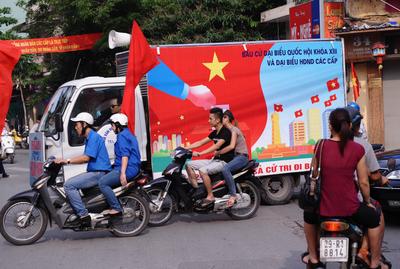This was followed three weeks later by a new resolution (Resolution 11) to re-balance the economy away from growth and toward macroeconomic stabilisation. This is to be achieved by tightening monetary policy, cutting back on fiscal spending, continuing with reform of the state-owned enterprises (SOEs) and building social safety nets.
The initial reaction to the large devaluation (the fourth in the past 18 months) was a further weakening of the dong as expectation of an inflation/devaluation spiral fuelled further capital flight into gold and US dollars. Subsequent administrative edicts to ban trading of gold and dollars in the open market, whilst emphasising the determination of the government, could have served to drive such activities underground. Still, raising the policy interest rate (four times in four months) from 9 to 14 per cent, and reducing the target credit growth to below 20 per cent per annum, did seem to have some impact, and the exchange rate began trading close to the official band. But the battle is far from over, as evidenced by yet another interest rate rise (to 15 per cent) last week. With one of the highest credit–GDP ratios in the region (Vietnam’s stock of credit is over 120 per cent of its GDP compared with around 50 to 80 per cent of GDP in the ASEAN 4 at similar stages of economic development in the mid-1990s), and an expected inflation rate of around 17 per cent (driven partly by rises in the administered prices of fuel and utilities), it would take greater and more sustained efforts to tame inflationary expectations. A clear mandate from the government to the State Bank of Vietnam to attain certain targeted-levels of inflation and international reserves would be a good start.
On the fiscal front, it has been reported that public investment is to be cut by 7.4 per cent this year, but guidance is badly needed on a trajectory of future government spending that would be consistent with macroeconomic stability. Furthermore, the key ministries of finance and planning need to have independence from political interference to conduct unbiased cost–benefit analyses of public investment projects, and to weed out those which are backed by powerful political interests but are economically wasteful.
As for the SOEs, the Ministry of Finance is currently attempting to set quotas on their foreign borrowings which would require them to seek approvals from the State Bank of Vietnam on a case by case basis. This move is no doubt a reaction to the near collapse and US$600 million debt default late last year of Vinashin (a huge state-owned shipbuilding, financial and real estate conglomerate) reportedly with political links to the Prime Minister Nguyen Tan Dung. Any increase in public oversight and improved governance of the large SOEs is a step in the right direction, but the authority and operational independence of the State Bank will be put to the test.
It is in this climate of macroeconomic weaknesses that Vietnam faced on 22 May an election of its 500-seat National Assembly. While there is no question that the Vietnamese Communist Party will continue to dominate, and Prime Minister Dung is widely expected to be re-elected, it is also clear that macroeconomic stability and continued rapid growth in living standards are key to the regime’s legitimacy. Support for strong public institutions (including the State Bank, the Ministry of Finance, and the Ministry of Planning and Investment) is an effective way of re-building public confidence in the macroeconomic foundations of the country.
So far, Vietnam still has the confidence of international investors, and has climbed onto the Asian production network gaining a foothold in parts and components manufacturing and assembly in electronics and related industries. (Samsung began mobile phone manufacturing in Vietnam in 2009. Intel commenced operations in Ho Chi Minh City in 2010, and Nokia set to open a factory in 2012). With wage rates climbing in China, significant opportunities are opening up for further investments in Vietnam. But much depends on the ability of the government to restore and re-build the public’s confidence in the country’s macroeconomic foundations before foot-loose foreign investors begin to sense trouble.
Suiwah Leung is Adjunct Associate Professor of Economics at the Crawford School of Economics and Government, Australian National University.

